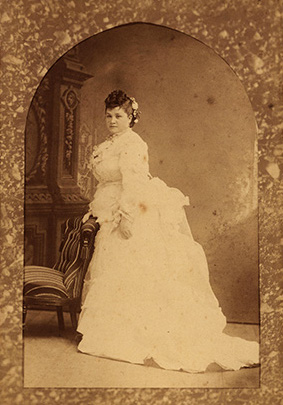
Encarnaciόn Pinedo ca. 1870
What’s at the heart of the Mission Church? Food, and lots of it.
From the early days of California settlers, to the day-to-day lives of Jesuits living in the Mission community, food has shaped culture and community at Santa Clara.
The SCU Archives & Special Collections has several important recipe books from the region, including Encarnaciόn Pinedo’s 1898 cookbook El Cocinero Español ("The Spanish Chef"), and Father Viader’s Miscellany Book, which reveal more than just the proper way to season scrambled eggs. They hint at a way of life.
“Back then it wasn’t like you could just go McDonald’s and pick up something to eat,” said Nia Olmstead, Communications and Events Coordinator for the University Library. “The process of cooking for so many people living together in the community was an all-day thing. The kitchen was always going.”
Encarnaciόn Pinedo was a member of a prominent family in the Santa Clara Valley during the mid-1800s. Her family built the first private residence in Santa Clara—a house located on what is now Alviso Street. And Pinedo’s godfather, James Alexander Forbes, worked to establish a school on the grounds of Mission Santa Clara—the precursor to the University of Santa Clara.
Pinedo’s cooking earned her recognition during her lifetime. Her Californian-Mexican cookbook, which is still widely distributed, features a mix of Mexican, Spanish, and Basque ingredients and recipes.
The book was daring by choice, as the foreword to the 2003 translation of El Cocinero Español notes: “Food, as Encarnación understood, can be a seductively delicious catalyst for social understanding, change, and even rebellious protest.” Her cooking was a way for her to achieve some economic freedom as a woman, and as a way to retain her mixed identity during times of blatant discrimination against indigenous and Mexican cultures.
Also digitized is a collection of 220 manuscripts assembled by Father José Viader, assistant to Father Magin Catalá, one of the most influential Franciscans in Mission Santa Clara. The Miscellany served as a reference guide for life in the Mission, touching on everything from how to properly maintain kitchen space—stocked with hatchets and machetes—to recipes for roasted apples, buñuelos (fried dough balls), and dried salmon.
“He probably would have been surprised that [his book] is still around hundreds of years later,” Olmstead said. “It was more like an operating manual because back then you had to write everything down. So after you went away or passed away, that knowledge would still be there. The fathers did use it after he died for many, many years.”
Their personal notes and thoughts offer glimpses into a past where Santa Clara County—nicknamed the Valley of Heart’s Delight—lived off its own livestock and agriculture. The recipes echo the realities of daily life, the traditional ceremonies accompanying church Holy Days and festivals, as well as the division of labor between Europeans and Native Americans.
“For Encarnación, it was clear she saw food as a way to bring people together,” Olmstead said. “All the recipes express heritage and history.”
Read El Cocinero Español and the memoirs of Encarnación Pinedo